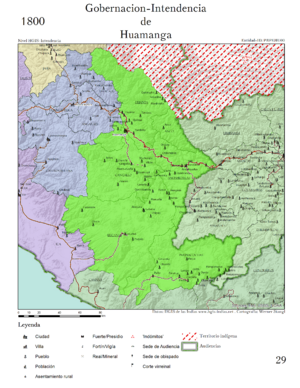Iquicha War of 1825–1828 facts for kids
Quick facts for kids Iquicha War of 1825–1828 |
|||||||
|---|---|---|---|---|---|---|---|
 Map of the Intendancy of Huamanga |
|||||||
|
|||||||
| Belligerents | |||||||
| Commanders and leaders | |||||||
Prudencio Huachaca † |
|||||||
The Iquicha War of 1825–1828 was a rebellion in Peru. It happened between 1825 and 1828. This conflict involved local peasants from Huanta called Iquichanos. They were loyal to the old Spanish rule. They fought against the army of the new Peruvian Republic.
Contents
The Iquicha War: A Fight for Loyalty
This war was an important event in early Peruvian history. It showed the challenges the new country faced. Not everyone agreed with Peru becoming independent from Spain. This rebellion was one example of that disagreement.
Who Were the Iquichanos?
The Iquichanos were mostly indigenous peasants. They lived in the mountainous region around Huanta. This area is part of what was then called the Intendancy of Huamanga. Today, it is the Department of Ayacucho.
Many Iquichanos felt a strong connection to the Spanish Crown. They had been loyal to Spain for a long time. They did not want to join the new Peruvian Republic. Their leader was a man named Antonio Huachaca.
Why Did the Iquichanos Rebel?
The main reason for the rebellion was their loyalty to Spain. The Iquichanos did not accept Peru's independence. They saw the new republic as a threat to their way of life. They also felt that the new government did not understand or respect them.
They believed that the Spanish king was their rightful ruler. They wanted to continue living under Spanish law. This made them "royalists," meaning they supported the monarchy.
The Conflict Begins
The war started in March 1825. This was soon after Peru declared its independence. The Iquichanos, led by Antonio Huachaca, began to fight. They used their knowledge of the mountain terrain to their advantage.
The Peruvian Republic sent its army to stop the rebellion. Important commanders like Andrés de Santa Cruz led the republican forces. The fighting was often fierce.
Key Moments in the War
The Iquichanos fought bravely. They used guerrilla tactics, which means small groups making surprise attacks. They knew the local mountains very well. This made it hard for the republican army to defeat them quickly.
Some Iquichano leaders were captured or killed. Nicolás Soregui was taken prisoner. Prudencio Huachaca was killed in action. But Antonio Huachaca continued to lead the resistance.
The End of the Rebellion
The Iquicha War lasted for over three years. It finally ended in June 1828. The Peruvian Republican army eventually won. This victory helped to establish the new republic's control over the region.
Even after this war, some tensions remained. The Iquichanos' loyalty to Spain showed how difficult it was to unite the new nation. The war is an important part of Peru's early history. It highlights the struggles of creating a new country.
See also
 In Spanish: Guerra de Iquicha (1825-1828) para niños
In Spanish: Guerra de Iquicha (1825-1828) para niños

